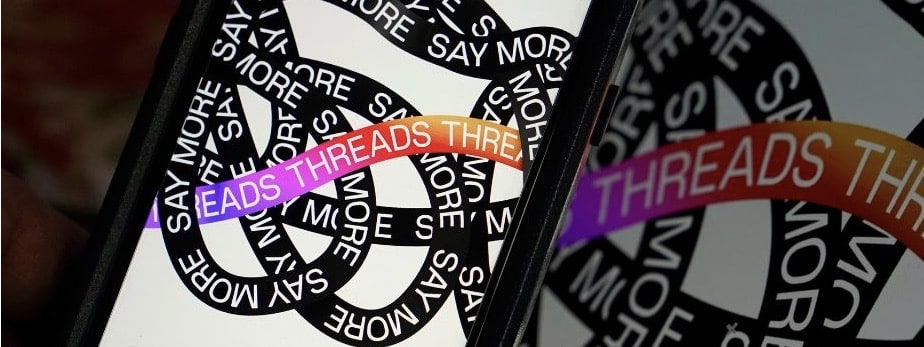In the dynamic world of social networking, a new contender has suddenly emerged: Threads, the latest app from Meta. Within its first 24 hours, over 30 million people signed up for Threads, an impressive launch for what’s been dubbed as Meta’s answer to Twitter.
But what makes Threads stand out? What can it bring to the increasingly homogenized social media landscape? And what’s in it for your brand or business?
Twitter’s cautionary tale
As I’ve begun exploring Threads, I find myself reminiscing about the early days of Twitter. The authentic conversations, connections, and communities that Twitter fostered were refreshingly sincere.
But Twitter evolved, and its transformation should serve as a cautionary tale. Twitter attempted to recruit new users by prioritizing more vibrant (and bombastic) voices, but in doing so, the platform diminished the essence of true conversation.
In its infancy, Threads appears to want something akin to Twitter’s early spirit of genuine engagement—yet it seems to initially lack rich content that could spark and foster more robust discussion. For now, at least, the platform is dominated by soundbites, memes, and content also shared via other channels.
Dude, where’s my Thread?
Ironically, despite its name, I have yet to see much threaded content on Threads. However, I wholeheartedly believe there’s potential for something unique by featuring its namesake. The idea of a platform that highlights long-form threaded content brings to mind the captivating threads by Tomas Pueyo on Twitter. Pueyo’s step-by-step exploration of historical events that shape the world today, such as how a series of mega-floods filled the Mediterranean Sea in a matter of months or why 75 percent of Texans live in “The Texas Triangle” between Houston, Dallas, and San Antonio, has captured my attention for hours at a time.
If Threads can promote long-form threaded content similar to Pueyo’s insightful Twitter threads, it might carve a distinct niche for itself in the social networking landscape.
What sets Threads apart?
Social networks and apps that survive the initial hype by building and sustaining an engaged user base usually bring something truly unique to the table. For instance, Instagram initially emphasized high-quality visual content, and TikTok introduced a personalized discovery algorithm that showcased engaging vertical videos.
By comparison, Threads doesn’t present any particularly innovative features. It’s somewhat of a hybrid between Instagram and Twitter, emphasizing text (with a 500-character limit per post) but also allowing photos, videos, and links.
But does Threads need a unique proposition to justify itself? Meta’s strength is its expansive social graph, powered by over 3 billion users. Will a strategy of giving users what they want by integrating trending features from other popular apps, backed by a formidable user base, be enough to sustain its growth?
A progressive alternative to Twitter
In her inaugural thread, Ellen DeGeneres labeled the Threads app as “Gay Twitter,” suggesting an intriguing perspective on the new platform’s role in the broader digital ecosystem. At a time when Twitter, under Elon Musk’s leadership, is increasingly seen as right-leaning, could Threads be embraced as its progressive counterpart? And might that be its ticket to success—or to marginalization?
In recent years, we’ve seen an increasing fragmentation of social networks along ideological lines. Take, for instance, PublicSq., a conservative social shopping app that enables users to make purchases “from businesses that align to your values,” recently ranked fourth in Apple’s U.S. App Store downloads.
Do our social media choices mirror our political beliefs? Such a development would not be surprising, especially given that an increasing number of Americans are relocating to live among like-minded individuals. Unfortunately, this trend reinforces ideological biases and nudges us deeper into our echo chambers.
Interestingly, new users joining Threads are invited to extend their Instagram presence by following the same users through an easy one-touch setup. This approach expedites audience growth, but it also reinforces those echo chambers, amplifying existing voices rather than introducing users to new perspectives.
In a potential future where businesses’ political and ideological positions influence user adoption and buying behaviors, will companies in tech (and other sectors) be able to remain neutral?
Should brands embrace Threads?
From a strategic standpoint, we are advising our clients to view this moment as an opportunity to experiment with Threads. Activate a Threads account for each existing Instagram account to safeguard your brand and provide an immediate follower boost.
In these initial stages, it’s essential to experiment with diverse types of content to understand what resonates with the audience, while remaining true to your overarching identity and brand. Begin by posting a variety of content types and closely monitor what generates strong engagement. Stay flexible, as Meta will likely refine its algorithm—which in turn may necessitate adjustments in your strategy.
While Threads offers an exciting new opportunity, maintaining a robust presence on established platforms like Twitter, with their unique and well-established spheres of influence, remains crucial.
As we venture into this new phase of social networking, one thing remains certain: The only constant is change. As Meta CEO Mark Zuckerberg stated, Threads aims to become the public conversations app for over a billion people, an opportunity he believes Twitter missed.
Whether Zuck’s vision will materialize is something only time will tell.



